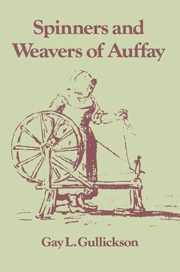 The Spinners and Weavers of Auffay
The Spinners and Weavers of Auffay Book contents
- Frontmatter
- Contents
- Preface
- 1 Introduction
- 2 The pays and the village
- 3 Proto-industrial theory and the pays de Caux
- 4 The golden age of spinning
- 5 Crisis and change in the Caux
- 6 The golden age of cottage weaving
- 7 Marriage and family in proto-industrial Auffay
- 8 Widowhood, remarriage, and the sexual division of labor
- 9 Unwed mothers and their children
- 10 Conclusions: the causes and consequences of proto-industrialization
- Appendix Vital statistics for Auffay
- Notes
- Bibliography
- Index
- Frontmatter
- Contents
- Preface
- 1 Introduction
- 2 The pays and the village
- 3 Proto-industrial theory and the pays de Caux
- 4 The golden age of spinning
- 5 Crisis and change in the Caux
- 6 The golden age of cottage weaving
- 7 Marriage and family in proto-industrial Auffay
- 8 Widowhood, remarriage, and the sexual division of labor
- 9 Unwed mothers and their children
- 10 Conclusions: the causes and consequences of proto-industrialization
- Appendix Vital statistics for Auffay
- Notes
- Bibliography
- Index
Summary
In the eighteenth century, travel and the transportation of crops and goods by road or water were laborious and time-consuming throughout Europe. As a result, regions produced grain crops, the staple of the peasant diet, even when the terrain and climate were poorly suited to their cultivation; cities were small; rural artisans produced shoes, barrels, plows, bricks, and furniture for local consumption; and peasant families who were basically identified with farming produced a variety of manufactured goods during the dead season in agriculture. For most peasants, the family's survival depended on the participation of everyone but the youngest children in this alternation of farming and manufacturing.
Some peasant families produced the raw materials from which they made goods to sell in local markets. Linen weavers and cord or rope makers often wove flax or braided hemp from their own plants, and weavers sometimes wove the wool from their own sheep. Other families received raw materials from merchants who put work out into the homes of peasants or cottage workers. Raw fibers or spun thread or yarn might come either from nearby areas or from some distance. All over Europe, weavers who produced high-quality woolens worked with wool from Spain's merino sheep. Silk weavers throughout France depended on the silk produced in the Rhone Valley, where mulberry trees and hence silk worms could be raised.
- Type
- Chapter
- Information
- The Spinners and Weavers of AuffayRural Industry and the Sexual Division of Labor in a French Village, pp. 1 - 6Publisher: Cambridge University PressPrint publication year: 1986


